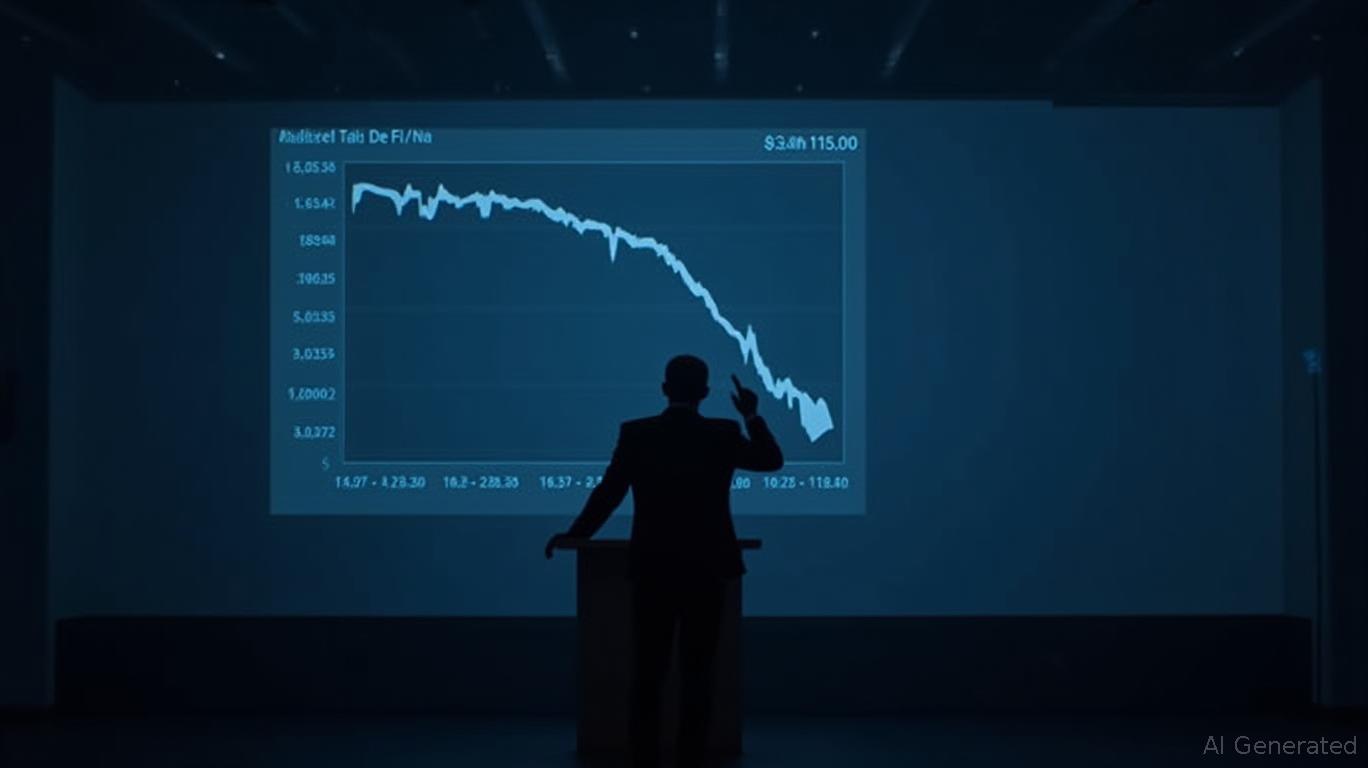"Hypervault’s $3.6M Exit: A Cautionary Tale for Unaudited DeFi" 改写如下: "Hypervault’s $3.6M Departure: A Warning Story for Unverified DeFi Projects"
- PeckShield uncovered a $3.6M exit scam from DeFi platform Hypervault, HyperEVM's largest rug pull, involving ETH transfers to Tornado Cash. - Project abruptly shut down by deleting all communication channels after users ignored prior warnings about fake audits and suspicious high-yield claims. - Incident highlights DeFi risks: 752 ETH ($3M) laundered via privacy tools, mirroring recent exploits and exposing vulnerabilities in un-audited protocols. - Hyperliquid faces governance scrutiny despite robust in

PeckShield, a blockchain security company, has reported that $3.6 million was withdrawn from the DeFi project Hypervault, making it one of the most significant rug pulls within the HyperEVM network. The stolen assets were transferred from Hyperliquid to
The abrupt downfall of the project came after its X (Twitter) account, Discord group, and official website were all taken offline, leaving users unable to retrieve their funds BeInCrypto, [ 4 ]. Prior to this, community members had pointed out warning signs, such as developers making false claims about security audits. On September 4, a user named HypingBull revealed that the project’s supposed audits by Pashov and Code4rena were fabricated, as both firms denied any involvement when contacted directly Cryptopolitan, [ 5 ]. Despite these alerts, Hypervault continued to draw in investors by advertising annual returns of 76–95% on stablecoins and HYPE liquidity.
This rug pull highlights the increasing dangers present in DeFi, especially for platforms lacking proper audits. PeckShield’s findings showed that 752 ETH—worth close to $3 million—was funneled into Tornado Cash, a common method for hiding transaction origins The Block, [ 1 ]. This incident is reminiscent of other recent attacks, such as the $4.5 million CrediX Finance rug pull in August 2025 Cryptonews, [ 2 ]. Hyperliquid, the Layer-1 blockchain that supports Hypervault, has come under fire for allowing risky yield projects, with critics warning that such third-party ventures can erode trust in otherwise solid infrastructure Cryptopolitan, [ 5 ].
This event has increased the competitive pressure on Hyperliquid, which has also been challenged by ASTER DEX’s daily trading volume of 13 billion and Trust Wallet’s recent integration. Arthur Hayes, a well-known member of the Hyperliquid community, had previously sold his HYPE holdings for $823,000, citing the risk posed by large token unlocks Cryptonews, [ 2 ]. Although Hyperliquid’s main infrastructure has not been directly affected, the rug pull has raised new concerns about the platform’s governance and vetting of ecosystem projects Cryptopolitan, [ 5 ].
Experts point out that Hypervault’s downfall serves as a warning about the perils of unregulated, high-yield DeFi protocols. The project had promoted itself as a multichain yield optimizer, taking advantage of HyperEVM’s liquidity aggregation Decrypt, [ 3 ]. However, its lack of openness—such as developer anonymity—stood in stark contrast to industry best practices. The situation also raises doubts about the effectiveness of community-driven alerts, as HypingBull’s September 4 warning was largely ignored until after the funds were drained Cryptopolitan, [ 5 ].
This incident may lead to renewed doubts about the DeFi sector as a whole. While Hyperliquid’s TVL remains above $2 billion, the Hypervault case shows that even well-capitalized ecosystems are not immune to bad actors Decrypt, [ 3 ]. Investors are being urged to focus on audited projects and to carefully assess yield promises. As of September 26, the HYPE token was trading at $41.61, down 23% for the week, reflecting the market’s uncertainty Decrypt, [ 3 ].
Disclaimer: The content of this article solely reflects the author's opinion and does not represent the platform in any capacity. This article is not intended to serve as a reference for making investment decisions.
You may also like
Ethereum Updates Today: Long-Term Investors Increase Holdings Amid Price Decline: Crypto Market Faces Growing Uncertainty
- Bitcoin and Ethereum face bearish pressure as ETF outflows persist, with Bitcoin near $95,000 and Ethereum below $3,200. - Institutional players like BitMine and FG Nexus adjust strategies amid declining hash prices and liquidity concerns. - Technical indicators like Bitcoin’s death cross and Ethereum’s oversold RSI signal prolonged weakness, with JPMorgan warning of risks for MSTR . - Coinbase’s D'Agostino sees the selloff as a buying opportunity for long-term holders, though structural buyer accumulati

Bitcoin Updates: Nvidia’s Surge in AI Drives Bitcoin Price Swings Amid Growing Concerns of a Market Bubble
- Nvidia's Q3 revenue hit $57.01B, driven by $51.2B in AI-focused data center sales, fueling Bitcoin's initial rebound above $91,000. - Bitcoin later fell to $86,400 amid AI bubble fears, mirroring 2025's pattern as analysts link its volatility to macroeconomic anxieties and overvaluation concerns. - CEO Huang highlighted sustained demand for Blackwell architecture, while regulators and investors warned of systemic risks from AI's rapid adoption and market fragility. - Bitcoin's 92% correlation with Nasdaq

Institutional integration and the Telegram network establish TON as the emerging benchmark in cryptocurrency
- TON (Telegram-integrated blockchain) gains traction as Coinbase expands $TON trading, boosting institutional adoption and liquidity. - TON Strategy Company (NASDAQ: TONX) reports $588.2M in digital assets, underscoring confidence in the token's long-term utility. - Analysts highlight TON's Telegram-driven ecosystem (1B+ users) and partnerships as key advantages over slowing projects like Chainlink (LINK). - Coinbase's Brazil DeFi expansion and stablecoin integration reinforce TON's positioning as a "glob

CBO reduces Trump tariff deficit by $1 trillion amid legislative disputes regarding rebate proposals
- CBO revised Trump-era tariff deficit savings downward by $1 trillion to $3 trillion through 2035, citing policy shifts like China-EU-Japan tariff cuts. - Legal challenges question Trump's executive authority on tariffs, with courts ruling against overreach while Supreme Court reviews cases. - Political clashes persist over $2,000 "tariff rebate" proposals, with Republicans prioritizing debt reduction over direct payments. - Economic analysis shows mixed impacts: short-term deficit reduction but uncertain
